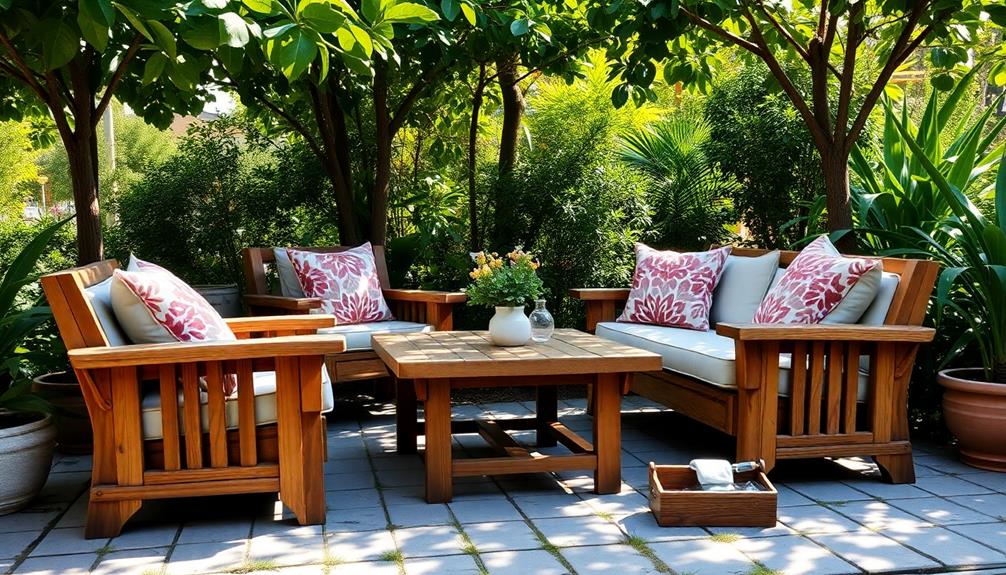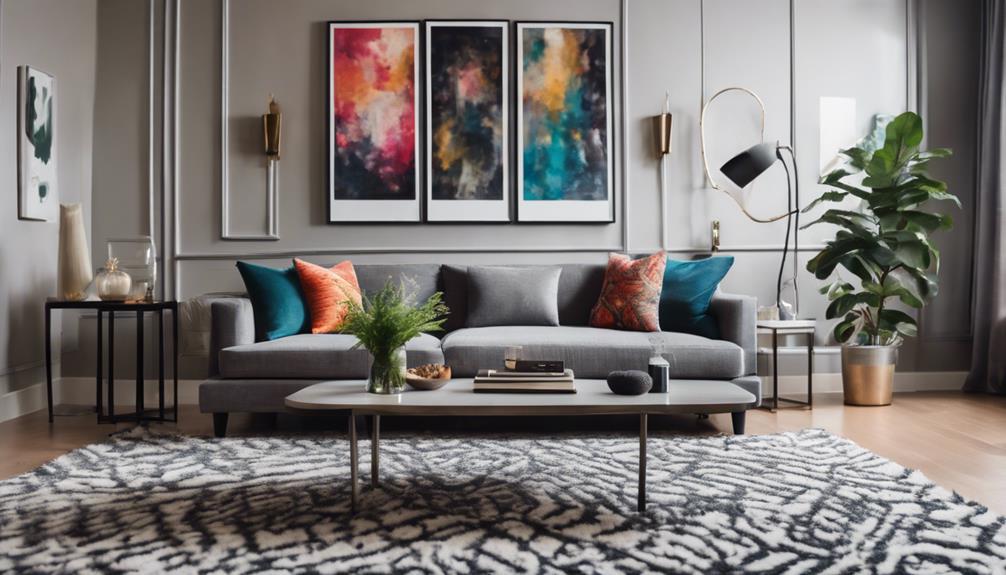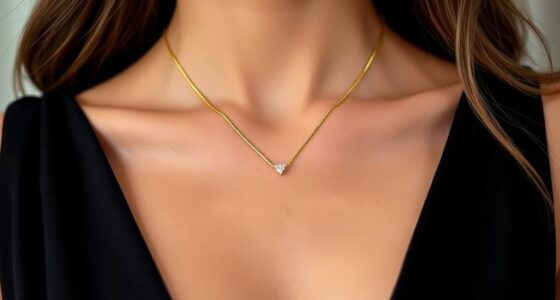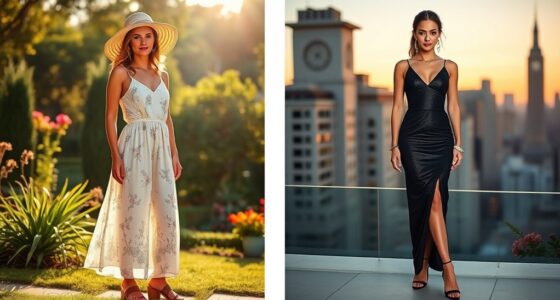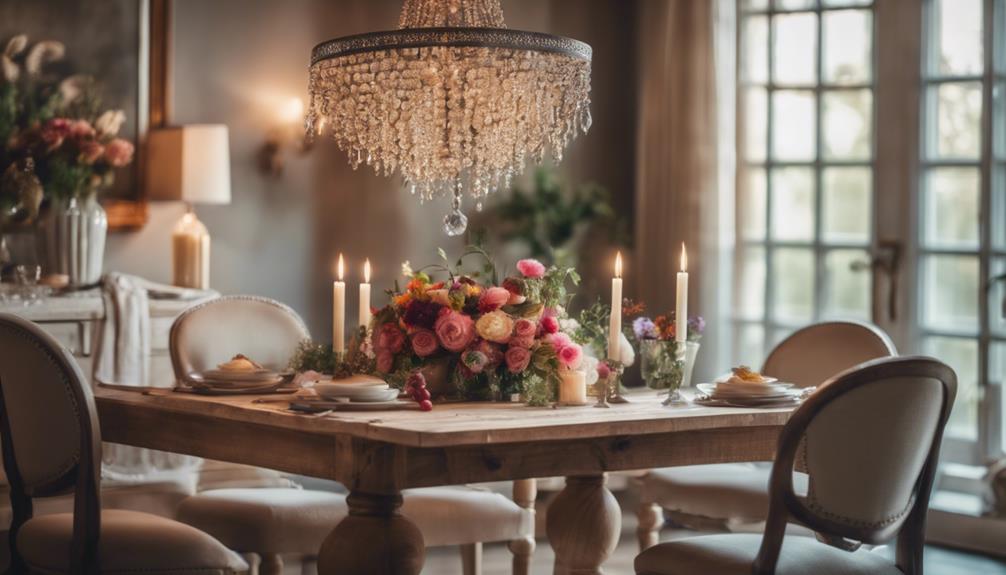Modern Spanish clothing redefines tradition by blending historical craftsmanship with fresh, contemporary styles. You'll find vibrant patterns and flamenco-inspired fabrics that bring a bold flair to today's fashion. Artisans incorporate intricate embroidery and local techniques, ensuring each piece resonates with Spain's rich cultural heritage. Emerging brands champion sustainability and individuality, offering stylish, unisex designs that empower your fashion choices. Whether you're layering dramatic pieces or upcycling vintage garments, you're embracing a unique identity. If you want to explore more about how this fusion shapes the future of fashion, you won't want to miss what's next.
Key Takeaways
- Modern Spanish clothing merges traditional craftsmanship with contemporary designs, reflecting Spain's rich artisanal heritage while appealing to today's fashion sensibilities.
- Flamenco-inspired elements, such as vibrant colors and ruffled layers, infuse modern styles with a bold flair that honors cultural roots.
- Sustainable practices are gaining traction, with brands like ECOALF and Thinking Mu prioritizing ethical production and eco-friendly materials in their collections.
- Fashion activism is reshaping the industry, as designers challenge gender norms and integrate feminist motifs into their innovative creations.
- The fusion of traditional garments with modern aesthetics through upcycling offers younger audiences a way to connect with Spanish culture while promoting individuality.
Origin and historical background of the fashion trend/style

Spanish fashion reflects a rich artisanal heritage, blending influences from art and architecture that have shaped its identity over centuries.
As you explore the intricate designs and vibrant colors in modern clothing, you'll see how these historical elements come to life.
This fusion not only honors tradition but also pushes boundaries in contemporary fashion.
Spanish Fashion's Artisanal Heritage
Rooted in a rich cultural heritage, Spanish fashion reflects centuries of traditional craftsmanship that continues to shape its identity today. Iconic pieces like the Mantón de Manila and espadrilles exemplify this artisanal heritage, showcasing intricate artistry and historical significance.
You'll find that the influence of Moorish designs and techniques dates back to Spain's Golden Age, where garments featured elaborate embroidery and unique silhouettes that set trends across Western Europe.
Artisans in regions like Valencia and Catalonia actively preserve these traditions, creating garments that marry local customs with quality craftsmanship. This commitment ensures that cultural heritage remains vibrant in modern fashion.
The evolution of Spanish fashion has embraced traditional elements, especially after Franco's dictatorship, which opened doors for vibrant self-expression in clothing.
Contemporary Spanish fashion houses such as Loewe and Delpozo honor this artisanal heritage by blending traditional craftsmanship with innovative materials and contemporary designs.
Their work showcases Spain's enduring influence in the global fashion landscape, allowing you to experience a unique blend of past and present.
In this way, Spanish fashion remains a dynamic reflection of its rich artisanal roots, continually redefining tradition for the 21st century.
Spanish Art and Architecture
With a vibrant tapestry of influences from various cultures, the art and architecture of Spain have profoundly shaped its fashion landscape. The Moorish, Roman, and Gothic styles weave together a rich historical background that resonates in Spanish art and its reflection in contemporary fashion. You can see this connection in the intricate designs and motifs of iconic structures like the Alhambra, which inspire modern clothing patterns and textile designs.
Traditional garments, such as flamenco dresses, showcase bold colors and elaborate details that mirror the vibrant tiles and ornate facades of Spanish architecture. This fusion of artistic elements celebrates cultural heritage while appealing to your modern sensibilities.
Designers today create innovative collections that draw from Spain's artistic legacy, incorporating influences from major art movements like Surrealism and Cubism. Fashion designers, such as Ágatha Ruiz De La Prada, blend playful and abstract elements into their creations, resulting in a unique blend of tradition and modernity. Adhesive strips are often employed in fashion displays to enhance the visibility of intricate designs.
This dynamic interplay between Spanish art, architecture, and fashion not only honors the past but also propels you into an exciting future where history and contemporary style coexist beautifully.
Key Characteristics

When you explore modern Spanish clothing, you'll notice vibrant patterns and textures that draw from the country's rich traditions.
Flamenco-inspired fabrics and statement accessories bring a bold flair to contemporary styles, making each piece feel alive and expressive.
These elements not only celebrate Spanish culture but also invite you to express your individuality.
Vibrant Patterns and Textures
Modern Spanish clothing bursts with vibrant patterns and textures that draw inspiration from the country's rich heritage.
You'll notice how contemporary designs often incorporate traditional elements, like bold geometric patterns popularized by Ágatha Ruiz De La Prada. This playful approach to fashion reflects a deep cultural connection while embracing modern aesthetics.
Intricate embroidery and lively floral motifs, reminiscent of the iconic Mantón de Manila shawl, are staples in many current collections. These features showcase a beautiful blend of craftsmanship and style, ensuring that the spirit of Spanish culture remains alive and relevant.
Textures play a crucial role, too; materials like lace, silk, and brocade evoke the opulence of Spain's fashion history while being reimagined in today's garments.
Designers such as Alejandro Gómez Palomo cleverly integrate traditional flamenco ruffles and polka dots into their silhouettes, proving that cultural motifs can seamlessly fit into modern wardrobes.
Emerging brands like EVADE HOUSE emphasize artisan craftsmanship, focusing on quality and individuality. By using vibrant colors and unique textures, they create statement-making garments that invite you to celebrate both tradition and innovation in your wardrobe.
Vibrant Flamenco Fabric Patterns
Flamenco fabric patterns embody the spirit of Spain with their vibrant colors and bold designs that capture the dance's passion and energy. These patterns often feature striking polka dots, floral motifs, and dynamic stripes that make flamenco attire truly stand out.
Traditional flamenco dresses, known as trajes de flamenca, incorporate these lively patterns, enhancing their visual impact during performances and creating a stunning dynamic silhouette.
The choice of lightweight materials, like cotton and silk, is essential for comfort and ease of movement, allowing dancers to express their artistry fully.
Regional styles further enrich flamenco fabric patterns, with Andalusian designs showcasing brighter hues that reflect the lively culture of the area. In contrast, other parts of Spain may favor more subdued tones, yet still maintain the essence of flamenco.
These fabric patterns do more than just please the eye; they serve as a vital expression of cultural identity, symbolizing the rich heritage tied to this beloved Spanish dance form.
Flamenco-Inspired Statement Accessories
Bold colors and intricate details define flamenco-inspired statement accessories, making them essential for anyone looking to elevate their outfit. These accessories often showcase a vibrant aesthetic, reflecting the flair of traditional flamenco attire through ruffles, polka dots, and floral motifs. Oversized earrings, embellished hair combs (peinetas), and hand-painted fans (abanicos) are popular choices that enhance your dramatic look.
The craftsmanship behind these pieces pays homage to traditional Spanish artisans, merging cultural heritage with modern design sensibilities. You'll find that many contemporary adaptations of flamenco accessories incorporate sustainable practices, using recycled materials and ethical production methods. This shift appeals to environmentally conscious consumers, ensuring you can wear these stunning pieces with pride.
Iconic Spanish brands and emerging designers are increasingly blending flamenco-inspired elements into their collections, showcasing the enduring influence of this traditional art form in today's fashion landscape.
When you choose flamenco-inspired statement accessories, you're not just adding flair to your ensemble; you're celebrating a rich cultural legacy while supporting sustainable fashion. So, go ahead and embrace the boldness—these accessories are sure to make a striking impression!
Modern Interpretation
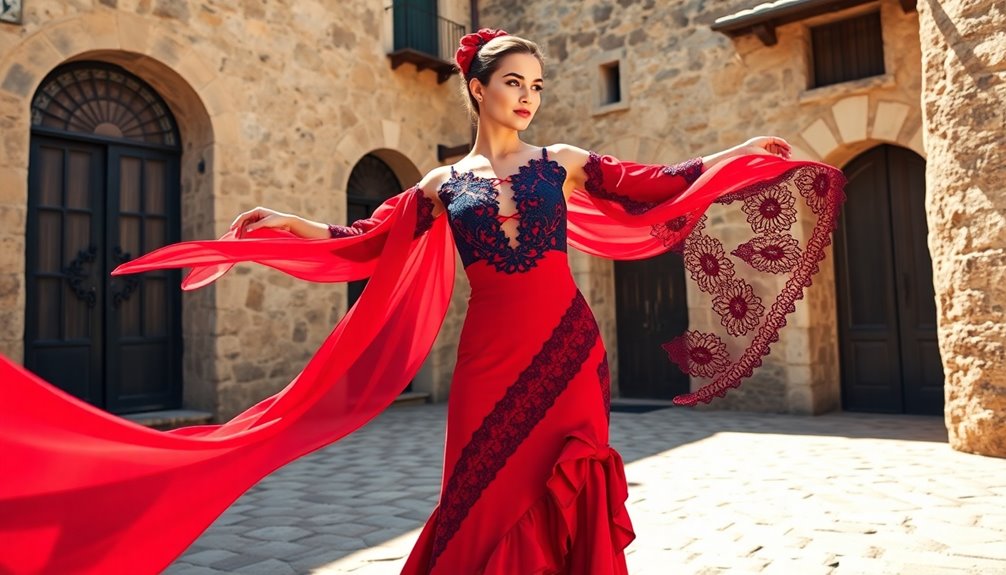
When you explore modern Spanish clothing, you'll notice a strong focus on sustainable fashion practices.
Emerging labels are collaborating with celebrities to create collections that not only reflect contemporary styles but also prioritize ethical production.
This shift shows how tradition and innovation can coexist in the fashion landscape, making it more relevant today.
Sustainable Fashion Practices
Sustainable fashion practices in contemporary Spain reflect a vibrant fusion of tradition and innovation, addressing the pressing need for eco-conscious choices. Brands like ECOALF lead the way by using recycled materials, effectively reducing waste and promoting a circular economy within the fashion industry. Their commitment to sustainability sets a powerful example for others to follow.
Thinking Mu emphasizes ethical production methods, crafting collections from organic cotton and natural dyes to minimize environmental impact. This approach resonates with consumers who prioritize environmentally conscious options.
Additionally, emerging designers like EVADE HOUSE and ACROMATYX champion local craftsmanship and sustainable practices, showcasing a shift toward responsible fashion consumption.
Innovation in sustainable fashion is also evident through advanced technologies. For instance, Fabrican's spray-on fabric allows for customization while significantly reducing material waste. This kind of innovation not only enhances the creative process but also aligns with a sustainable ethos.
As consumer demand for sustainable practices continues to grow, Spanish fashion initiatives are increasingly blending traditional craftsmanship with modern sensibilities, creating a dynamic landscape that respects both the environment and cultural heritage. Furthermore, the incorporation of antioxidants in coffee into the diets of consumers can complement their sustainable lifestyle by promoting overall health.
Embracing these practices allows you to make more informed choices in your wardrobe.
Emerging Sustainable Fashion Labels
A growing wave of emerging sustainable fashion labels in Spain is redefining how you think about style and responsibility. Brands like ECOALF are leading the charge by utilizing recycled materials to create eco-friendly clothing, supporting a circular economy in fashion.
Thinking Mu takes a stand with its commitment to ethical production, sourcing organic cotton and using natural dyes to cater to your eco-conscious desires.
ACROMATYX, founded in 2021, merges artisanal tailoring with modern aesthetics while showcasing the importance of craftsmanship and local artisan collaborations, reinforcing sustainability in every stitch.
Meanwhile, PALOMO SPAIN beautifully blends traditional Spanish elements with contemporary designs, promoting inclusivity through unisex garments and emphasizing sustainable production methods.
This growing number of independent labels is challenging fast fashion giants like Zara and Mango. By focusing on quality, sustainability, and local talent, they reflect a cultural shift towards valuing heritage and responsible consumption.
As you explore these brands, you'll discover that style can harmoniously coexist with ethics, proving that fashion in the 21st century can be both beautiful and kind to our planet.
Celebrity Fashion Collaborations
Celebrity fashion collaborations in Spain are redefining modern style by merging traditional craftsmanship with contemporary aesthetics. Take Rosalía's partnership with Ralph Lauren, for instance. It celebrates Spanish heritage through innovative design interpretations that resonate with today's fashion-forward audience.
Similarly, C. Tangana's collaborations not only blend music and fashion but also infuse traditional Spanish elements, crafting a unique cultural narrative that appeals to younger fans.
Emerging brands like PALOMO SPAIN exemplify how these collaborations promote inclusivity and self-expression, reimagining classic Spanish styles for a modern audience. You'll often see influencers and celebrities showcasing designs from sustainable labels like EVADE HOUSE, which emphasizes sustainability and craftsmanship, adding a fresh spin to traditional attire.
Moreover, Spanish designers cleverly leverage celebrity endorsements to enhance brand visibility, especially during high-profile red carpet events. This strategy not only boosts global appeal but also ensures that traditional craftsmanship receives the recognition it deserves.
As you explore this evolving landscape, you'll notice how these collaborations are shaping the future of fashion in Spain, marrying heritage with modern aesthetics for a vibrant, inclusive expression of style. Additionally, the rise of sustainable grooming practices has influenced fashion brands to adopt eco-friendly materials in their collections, reflecting a broader cultural shift towards environmental consciousness.
Styling Tips
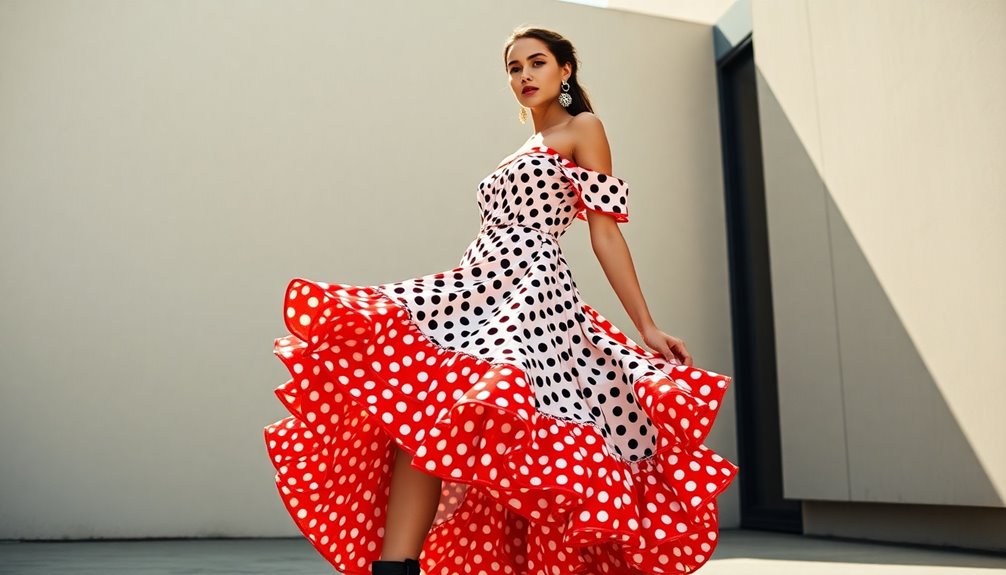
When you want to make a statement, consider incorporating flamenco skirts into your wardrobe; their vibrant designs can really elevate your outfit.
Layering techniques inspired by traditional flamenco styles can help you create dynamic looks that transition seamlessly from day to night.
Mixing modern and traditional elements not only showcases your unique style but also honors Spanish heritage.
Statement Flamenco Skirts
In recent years, statement flamenco skirts have made a vibrant comeback, captivating fashion enthusiasts with their bold colors and dramatic ruffles. To style these eye-catching pieces, pair your statement flamenco skirt with a fitted top to create a balanced silhouette that highlights its flair. This combination allows the skirt's vibrant colors to shine while maintaining a polished look.
To enhance the traditional aesthetic, consider accessorizing with a mantilla or a peineta, adding authenticity and elegance to your outfit. When it comes to footwear, opting for flamenco shoes or heels with a sturdy base is essential. This choice ensures both style and comfort, allowing you to move gracefully in your skirt.
For a modern twist, layer your flamenco skirt with a cropped jacket or bolero. This adds versatility, making it easy to transition from day to night events. Incorporating contemporary fabrics, like lightweight cotton or sustainable materials, can modernize the classic skirt while honoring its cultural significance and craftsmanship. Moreover, choosing healthier snacks can help maintain good oral hygiene and prevent potential dental issues, ensuring that your smile complements your stunning outfit.
With these styling tips, you'll confidently embrace the boldness of statement flamenco skirts while celebrating their rich heritage.
Flamenco-Inspired Layering Techniques
Building on the boldness of statement flamenco skirts, flamenco-inspired layering techniques allow you to create dynamic and eye-catching outfits. To embrace this style, incorporate ruffled layers reminiscent of traditional flamenco dresses into your contemporary outfits. Using fabrics like silk or chiffon will create movement and fluidity, enhancing your look.
Utilize vibrant colors and polka dot patterns that are characteristic of flamenco attire. These elements add boldness and energy, reflecting the rich cultural heritage of Spanish fashion. Mix and match various lengths of skirts and dresses; pair a long, flowy skirt with a shorter, fitted top for a modern twist on flamenco-inspired layering.
Accessorizing is key. Traditional footwear like flamenco shoes or ankle boots can enhance your layered outfit while ensuring comfort and style.
Don't forget to experiment with shawls or mantillas. Draping a Mantón de Manila over your shoulders or around your waist adds depth and texture, enriching your ensemble.
Layering Traditional and Modern Styles
Layering traditional and modern styles can transform your wardrobe into a vibrant expression of cultural heritage and contemporary fashion. Start by incorporating traditional Spanish accessories like a mantón de Manila or an abanico. These pieces add a unique touch of cultural heritage, enhancing your modern outfits while keeping the aesthetics fresh.
For a chic look, layer fitted blouses with flamenco-inspired ruffled skirts and pair them with tailored jackets. This combination fuses elegance and modernity beautifully.
You can also mix classic espadrilles with casual streetwear, such as denim or tailored trousers, blending traditional footwear seamlessly with current fashion trends.
Don’t shy away from experimenting with bold patterns and colors reminiscent of traditional Spanish attire. Polka dots and bright florals can create striking statement pieces within your modern wardrobe. These vibrant elements can easily be integrated into your outfits, allowing you to blend cultural influences with contemporary style. Pairing bold patterns with neutral basics can create a perfect balance, ensuring your look remains chic yet playful. Incorporating such unique pieces into your collection will elevate your sophisticated everyday clothing essentials, making even the simplest outfits stand out.
Additionally, consider layering techniques using sustainable materials like organic cotton and jute. This approach honors the craftsmanship of traditional Spanish textiles while promoting eco-friendly fashion choices.
Shopping Guide
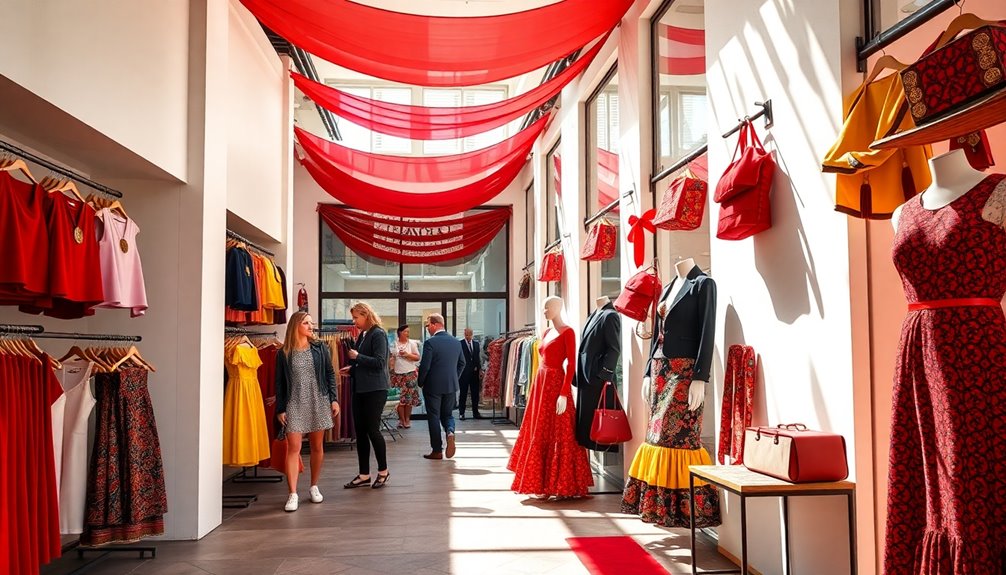
Discovering modern Spanish clothing is an exciting journey that blends tradition with contemporary style. When you're on the hunt for unique pieces, prioritize brands that emphasize sustainability and craftsmanship, like ECOALF and Thinking Mu. These labels use recycled materials and organic fabrics, ensuring your wardrobe choices are eco-friendly.
Don't overlook emerging designers such as PALOMO SPAIN and ACROMATYX, who redefine Spanish fashion with contemporary aesthetics that honor local heritage and inclusivity. Major retailers like Zara and Mango can also be great stops, offering stylish options that reflect current trends while staying rooted in Spanish cultural influences.
To get a firsthand experience, attend fashion weeks in Madrid and Barcelona. Here, you can discover new collections and connect with the designers shaping the future of Spanish fashion.
Also, make time to explore local markets and boutiques in these cities; they're treasure troves of unique pieces that fuse traditional Spanish elements with modern design. By supporting these independent labels and local artisans, you'll not only elevate your style but also contribute to a more sustainable fashion ecosystem.
Happy shopping!
Upcycling Vintage Spanish Garments
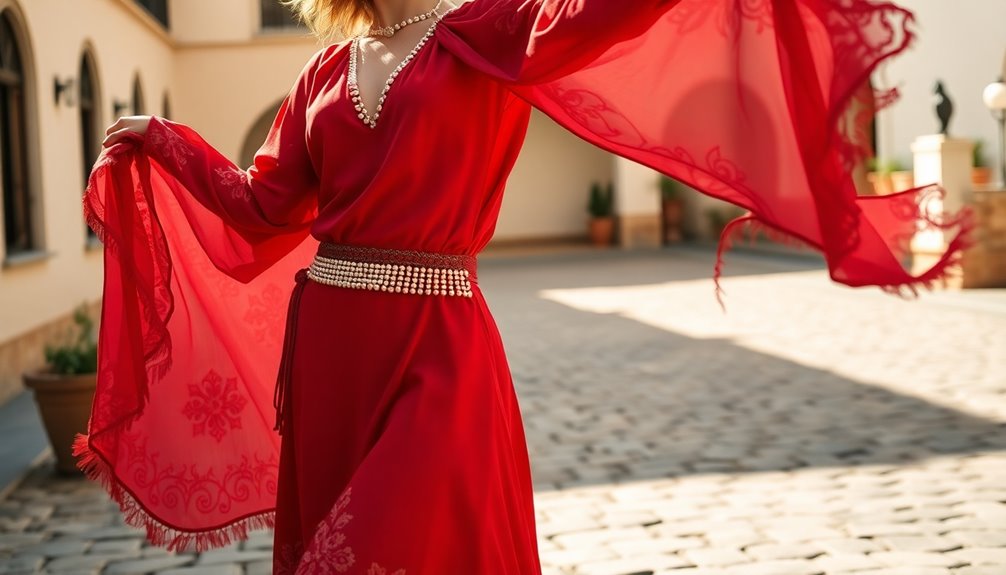
When you think about upcycling, consider the beauty of an upcycled Mantón De Manila, a traditional shawl that can be reimagined into a modern accessory.
By incorporating embroidered personalization techniques, you can create a unique piece that reflects your style while honoring Spanish heritage.
This blend of old and new not only reduces waste but also tells a story of craftsmanship and culture.
Upcycled Mantón De Manila
Embracing the rich cultural heritage of Spain, contemporary designers are breathing new life into the Mantón de Manila through innovative upcycling. By transforming vintage Mantón de Manila pieces, they're creating modern garments that not only reduce waste but also celebrate the intricate craftsmanship of traditional artisans.
This approach allows you to wear unique fashion statements infused with historical significance. Designers like Palomo Spain reinterpret the iconic shawl, incorporating vibrant floral motifs and luxurious fabrics into contemporary silhouettes.
The upcycled mantón de Manila not only showcases artistic heritage but also reflects a commitment to sustainability in fashion. As brands increasingly focus on eco-friendly practices, you're given the chance to support a movement that values repurposing traditional garments.
The blend of traditional techniques and innovative designs appeals to a younger audience like you, eager to connect with Spanish culture in a modern context. By choosing upcycled pieces, you contribute to a fashion landscape that honors the past while embracing the future.
Embroidered Personalization Techniques
Countless vintage Spanish garments are being transformed through embroidered personalization techniques, breathing new life into once-forgotten pieces. By embracing upcycling, you not only reduce waste but also support sustainability within the fashion industry.
Artisans utilize motifs inspired by Spanish cultural heritage, like floral designs and geometric patterns, to enhance these garments while preserving their historical significance. This approach fosters individuality and creativity, allowing you to wear unique pieces that stand out from mass-produced items.
Emerging brands, such as ACROMATYX, focus on merging artisanal tailoring with modern aesthetics, catering to consumers who appreciate the value of local craftsmanship. As you explore these personalized embroidered pieces, you'll find a strong connection to cultural roots that resonates with a growing demand for sustainable fashion choices.
Each stitch tells a story, reflecting the passion and skill of the artisans behind the work. In a world where fast fashion dominates, choosing upcycled garments adorned with embroidered personalization techniques not only elevates your wardrobe but also champions a movement that honors tradition while pushing the boundaries of contemporary style.
Additionally, the practice of upcycling vintage fashion aligns with a broader trend of promoting mindfulness and presence in consumption choices.
Embrace this trend, and let your clothes speak to your individuality.
Cultural Impact

You can't overlook how flamenco influences contemporary music and fashion, highlighting Spain's rich cultural heritage.
As you explore the intersection of fashion activism and gender equality, you'll see how traditional garments are reinterpreted to challenge norms and empower individuals.
This cultural impact not only shapes identity but also sparks conversations about community and sustainability in modern Spanish clothing.
Flamenco in Contemporary Music
Flamenco's vibrant rhythms and passionate melodies have found a fresh expression in contemporary music, captivating a new generation. As UNESCO recognizes flamenco as an Intangible Cultural Heritage, its traditional elements blend seamlessly with modern influences.
Artists like Rosalía and C. Tangana are at the forefront, incorporating flamenco aesthetics and rhythms into their work to create a fusion that resonates with younger audiences.
Rosalía's album "El Mal Querer" exemplifies this integration, addressing themes of gender norms and societal issues while preserving the emotional depth inherent in flamenco. Music videos featuring traditional symbols like ruffles and abanicos create a dialogue between Spain's historical roots and contemporary fashion, visually linking the past with the present.
Collaborations across genres like pop and hip-hop highlight flamenco's versatility, showcasing its adaptability and enduring relevance in the global music scene.
This evolution not only celebrates Spanish cultural heritage but also invites listeners to experience flamenco in a new light, challenging preconceived notions and expanding its audience.
Through these modern interpretations, flamenco continues to thrive, proving that tradition can coexist with innovation in the ever-evolving world of music.
Fashion Activism and Gender Equality
Fashion activism in Spain has emerged as a powerful force for gender equality, reshaping the landscape of contemporary design. Spanish designers like Alejandro Gómez Palomo are challenging traditional gender norms by creating unisex garments that celebrate individuality and self-expression. This shift not only promotes inclusivity but also enhances women's empowerment, allowing everyone to express their cultural identity through fashion.
Artists like Rosalía further amplify this message, using their platforms to address sexism and violence. Her album "El mal querer" intertwines music and fashion, conveying critical themes about women's rights and societal constraints.
Collections from brands like ACROMATYX showcase feminist motifs, emphasizing a growing awareness of gender issues within contemporary Spanish fashion.
Moreover, collaborations between fashion brands and social movements foster dialogue around gender equality, urging the younger generation to embrace these values.
Spanish designers are increasingly leveraging their influence to promote initiatives that challenge stereotypes and advocate for women's empowerment. By doing so, they not only redefine fashion but also inspire a collective movement towards a more equitable society, making fashion activism an integral part of Spain's cultural narrative.
Frequently Asked Questions
What Is the Clothing Culture in Spain?
Spain's clothing culture is vibrant and diverse, reflecting its rich history and regional customs.
You'll notice traditional outfits like the traje de flamenca or traje de luces during festivals, showcasing craftsmanship and community pride.
Each region boasts its own unique styles, from Valencia's elaborate Falleras costumes to the Basque txapela berets.
As you explore, you'll see how contemporary designers blend these traditions with modern flair, creating a dynamic fashion scene that celebrates Spain's cultural identity.
What Is Spain's Influence on the Fashion Industry?
Spain's influence on the fashion industry is undeniable.
You'll notice how Spanish designers like Balenciaga and Loewe set trends with their innovative styles. Fashion weeks in Madrid and Barcelona showcase this creativity, drawing global attention.
Retailers like Zara have revolutionized fast fashion, making chic designs accessible.
Plus, the integration of traditional elements into modern pieces highlights Spain's rich cultural heritage, appealing to those who value authenticity and craftsmanship in their wardrobes.
What Clothes Are Trending in Spain?
Right now, you'll see oversized silhouettes like baggy trousers and blazers taking center stage in Spain, reflecting a relaxed vibe.
Bold colors, polka dots, and floral prints are everywhere, adding a lively touch to your wardrobe.
Sustainable fashion's on the rise, with brands using recycled materials.
Plus, traditional garments, like flamenco dresses, are being reimagined in streetwear.
And don't forget about unisex lines that challenge gender norms, making fashion more inclusive than ever.
What Is the Most Famous Dress in Spain?
The most famous dress in Spain is the traje de flamenca. When you see this vibrant dress, with its ruffles and polka dots, you can't help but feel the festive spirit of events like the Feria de Abril in Seville.
Its fitted bodice and flared skirt reflect the rich cultural heritage of Andalusia. In modern times, designers are updating its style, making it a beloved symbol of Spanish identity that resonates globally.

